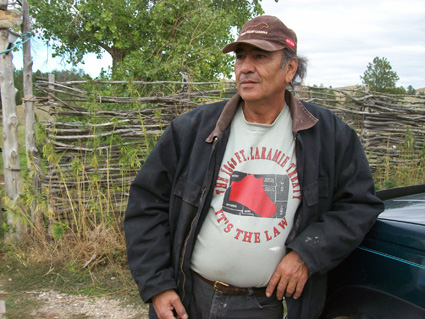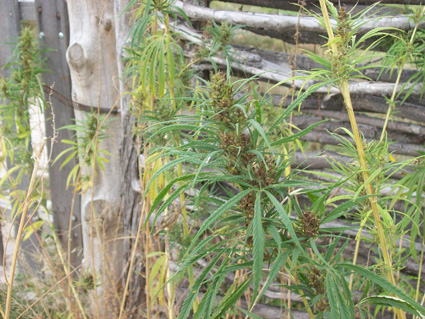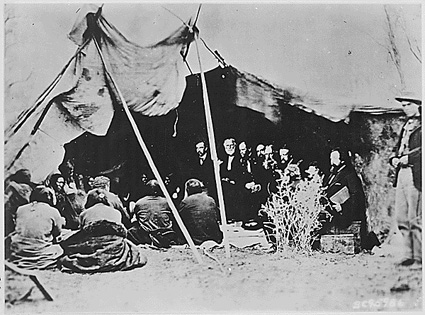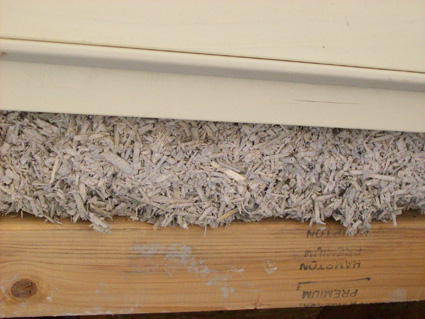Alex is the former Tribal President of the Oglala Sioux Tribe of South Dakota. He lives on the Pine Ridge Indian Reservation of South Dakota.
Alex bears the remarkable distinction of being the only person in the United States to successfully farm and complete a legal hemp crop within the borders of the USA since 1968. comment
I had the rare & unique opportunity to meet Alex while visiting the Indian Nations of the Pine Ridge Reservation last September. He graciously allowed me to photograph him, and some of his hemp plants while there.

Alex White Plume in front of some of his hemp crop.
The hemp that Alex grows is NOT the kind that gets you high. It is a mutated form of hemp that is THC FREE! This is confirmed by independent USDA laboratory testing done at the request of the DEA.
Alex's weed is grown for its industrial applications, and is used as a building materiel and for paper-making. This is VERY IMPORTANT. The Pine Ridge Reservation is one of the poorest, most impoverished places in the USA, if not THE most impoverished. By being able to use industrial hemp as a construction materiel, it allows inhabitants of the "Res" to produce buildings at virtually no cost for the physical load bearing structures themselves. (Walls, ceilings, etc...)

Wild THC-Free mutated hemp growing in parking lot of Alex White Plume's house. Note the seeds in the bud, obviously this is NOT weed grown for recreational purposes.
This allows affordable housing in a place with the highest unemployment rate in America. Here's how it works.
In 1868, General William T. Sherman negotiated and signed the "TREATY OF FORT LARAMIE OF 1868", on behalf of the United States, and the Lakota nation, Yanktonai Sioux, Santee Sioux, and Arapaho peoples. The treaty ended Red Cloud's War, and it also recognized limited sovereignty of the Indian nations named above, granting them ownership of the Black Hills.

The Treaty of Ft. Laramie of 1868
There is also language in the treaty granting federal assistance to any Indians who want to engage in farming on the reservation.
With the local autonomy granted to the Indian Nations under treaty law, the Oglala Sioux on Pine Ridge are exempt from much of US law. Local traditional Indian law takes precedence instead.
As a Tribal President of the Oglala Sioux, Alex exercised his tribal sovereignty by planting the 1st legal crop of industrial hemp grown in the US since 1969.
When harvest time came, he invited the DEA to come observe his harvest. The showed up about 2 weeks early, & surrounded his home and fields with snipers and infantry, and they brought a tank. Then the DEA proceeded to plow the crop under, and destroy the harvest. However, when it came time to go to court to prove that Alex was actually breaking the law, the DEA was unable to actually PROVE that the industrial grade hemp was actually illegal, because the strain of wild hemp grow on the Reservation was a mutated strain that was, (To everyone's surprise!) THC FREE!
The following season, to the delight of the Indians, it turned out that when the DEA plowed their crops under in an attempt to destroy them, the seeds on those plants germinated & started growing, right in the same fields where they had been plowed under!
Well, I guess it IS a "weed", and um, grows like...weeds.
Since then the Oglala have managed to complete several harvests, converting their locally grown strain of industrial grade Indian hemp into building materiels. The harvested hemp is stripped in the fields where it is grown. allowing the seeds to drop into the field where it grows, to insure future crops, and allowing the decomposing leaf matter to compost in place, to provide fertilization for the field for future crops. Then the stripped hemp stalks are dried and chipped, to provide the basic filler materiel for insulation in buildings built on the reservation, and to provide the needed chaff to reinforce an adobe mixture used in those same structures.

Hemp Stalk chaff showing its place in a structure as insulation
This allows for the construction of buildings on the reservation that are effectively cost-free, because by using resources that the reservation has in abundance (Hemp, mud, water) they can build houses without having to pay for construction supplies, and with labor being provided on a sweat-equity basis by the people who will use or inhabit those buildings, labor costs become minimal.
In a place with 85% unemployment, this is really important, as it provides not only cost free housing, but it also allows the development of a source of employment and tools for the development of a skilled labor force. It's truly an elegant model for economic self-help and development for the Indian nations of Pine Ridge.
When I interviewed Alex, he said that "You HAVE to have respect for the dirt, for the soil, it's alive". The Oglala words for the dirt are "Ma Kanea", and the dirt is very important to the Oglala.
"If you lay in the dirt for a couple of weeks, the dirt will start to consume you" says Alex, who also tells me that "Ashes to ashes, dust to dust, All this these things that the Christians believe, the Oglala have been practicing for thousands of years".
Considering that the hemp he grows is mixed in with dirt and water to make adobe , it makes it clear to me how respect for the dirt is an integral part of his program.
If only the rest of the country could see how respecting the natural surroundings and integrating it's locally available resources into it's local economies would aid in developing those same economies and ecologies, we would all be a bit better off, and have saved a considerable deal of money at the same time.
Alex bears the remarkable distinction of being the only person in the United States to successfully farm and complete a legal hemp crop within the borders of the USA since 1968. comment
I had the rare & unique opportunity to meet Alex while visiting the Indian Nations of the Pine Ridge Reservation last September. He graciously allowed me to photograph him, and some of his hemp plants while there.

Alex White Plume in front of some of his hemp crop.
The hemp that Alex grows is NOT the kind that gets you high. It is a mutated form of hemp that is THC FREE! This is confirmed by independent USDA laboratory testing done at the request of the DEA.
Alex's weed is grown for its industrial applications, and is used as a building materiel and for paper-making. This is VERY IMPORTANT. The Pine Ridge Reservation is one of the poorest, most impoverished places in the USA, if not THE most impoverished. By being able to use industrial hemp as a construction materiel, it allows inhabitants of the "Res" to produce buildings at virtually no cost for the physical load bearing structures themselves. (Walls, ceilings, etc...)

Wild THC-Free mutated hemp growing in parking lot of Alex White Plume's house. Note the seeds in the bud, obviously this is NOT weed grown for recreational purposes.
This allows affordable housing in a place with the highest unemployment rate in America. Here's how it works.
In 1868, General William T. Sherman negotiated and signed the "TREATY OF FORT LARAMIE OF 1868", on behalf of the United States, and the Lakota nation, Yanktonai Sioux, Santee Sioux, and Arapaho peoples. The treaty ended Red Cloud's War, and it also recognized limited sovereignty of the Indian nations named above, granting them ownership of the Black Hills.

The Treaty of Ft. Laramie of 1868
There is also language in the treaty granting federal assistance to any Indians who want to engage in farming on the reservation.
With the local autonomy granted to the Indian Nations under treaty law, the Oglala Sioux on Pine Ridge are exempt from much of US law. Local traditional Indian law takes precedence instead.
As a Tribal President of the Oglala Sioux, Alex exercised his tribal sovereignty by planting the 1st legal crop of industrial hemp grown in the US since 1969.
When harvest time came, he invited the DEA to come observe his harvest. The showed up about 2 weeks early, & surrounded his home and fields with snipers and infantry, and they brought a tank. Then the DEA proceeded to plow the crop under, and destroy the harvest. However, when it came time to go to court to prove that Alex was actually breaking the law, the DEA was unable to actually PROVE that the industrial grade hemp was actually illegal, because the strain of wild hemp grow on the Reservation was a mutated strain that was, (To everyone's surprise!) THC FREE!
The following season, to the delight of the Indians, it turned out that when the DEA plowed their crops under in an attempt to destroy them, the seeds on those plants germinated & started growing, right in the same fields where they had been plowed under!
Well, I guess it IS a "weed", and um, grows like...weeds.
Since then the Oglala have managed to complete several harvests, converting their locally grown strain of industrial grade Indian hemp into building materiels. The harvested hemp is stripped in the fields where it is grown. allowing the seeds to drop into the field where it grows, to insure future crops, and allowing the decomposing leaf matter to compost in place, to provide fertilization for the field for future crops. Then the stripped hemp stalks are dried and chipped, to provide the basic filler materiel for insulation in buildings built on the reservation, and to provide the needed chaff to reinforce an adobe mixture used in those same structures.

Hemp Stalk chaff showing its place in a structure as insulation
This allows for the construction of buildings on the reservation that are effectively cost-free, because by using resources that the reservation has in abundance (Hemp, mud, water) they can build houses without having to pay for construction supplies, and with labor being provided on a sweat-equity basis by the people who will use or inhabit those buildings, labor costs become minimal.
In a place with 85% unemployment, this is really important, as it provides not only cost free housing, but it also allows the development of a source of employment and tools for the development of a skilled labor force. It's truly an elegant model for economic self-help and development for the Indian nations of Pine Ridge.
When I interviewed Alex, he said that "You HAVE to have respect for the dirt, for the soil, it's alive". The Oglala words for the dirt are "Ma Kanea", and the dirt is very important to the Oglala.
"If you lay in the dirt for a couple of weeks, the dirt will start to consume you" says Alex, who also tells me that "Ashes to ashes, dust to dust, All this these things that the Christians believe, the Oglala have been practicing for thousands of years".
Considering that the hemp he grows is mixed in with dirt and water to make adobe , it makes it clear to me how respect for the dirt is an integral part of his program.
If only the rest of the country could see how respecting the natural surroundings and integrating it's locally available resources into it's local economies would aid in developing those same economies and ecologies, we would all be a bit better off, and have saved a considerable deal of money at the same time.
